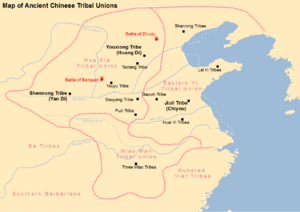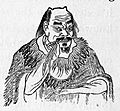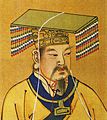Three Sovereigns and Five Emperors facts for kids
Quick facts for kids Three Sovereigns and Five Emperors |
|||||||||
|---|---|---|---|---|---|---|---|---|---|
| Chinese | 三皇五帝 | ||||||||
|
|||||||||
The Three Sovereigns and Five Emperors were important leaders from ancient China. They are mostly known from Chinese mythology and old stories. People today see them as culture heroes, meaning they helped shape Chinese culture. Long ago, people believed they were like gods or powerful spirits who were ancestors. This time period happened before the Xia Dynasty, which was the first known dynasty in China.
In these old stories, the Three Sovereigns were like powerful beings or demigods. They used their special abilities to help create humans and teach them important skills. These skills included how to live and how to understand the world. The Five Emperors were wise and good leaders. They were known for their strong moral character. This time was seen as a "golden age" where people and gods could communicate easily. These wise leaders either embodied the divine or helped people talk to divine forces.
During this period, leaders were chosen through a system called abdication system. This meant a ruler would give up their power to a chosen successor. This changed when Qi of Xia took power by force. He started a system where power was passed down in families, creating a hereditary monarchy.
Contents
Ancient Stories
Many ancient stories about the Three Sovereigns come from Taoism. These tales often include ideas from Shamanism, which is a practice where people believe they can connect with spirits. The oldest stories about Fuxi, Nüwa, and Shennong as the Three Sovereigns were inspired by these beliefs.
Different Lists of Rulers

There are many different ideas about who exactly the Three Sovereigns or Five Emperors were. This depends on which ancient book or source you read. There are about six or seven different lists! Many of these sources were written much later than the time these rulers supposedly lived.
Some of the names that often appear as Three Sovereigns include: Fuxi (伏羲), Nüwa (女媧), Shennong (神農), Suiren (燧人), Zhurong (祝融), Gong Gong (共工), Heavenly Sovereign (天皇), Earthly Sovereign (地皇), Tai Sovereign (泰皇), Human Sovereign (人皇), and even the Yellow Emperor (黄帝).
For the Five Emperors, common names are: Yellow Emperor (黃帝), Zhuanxu (顓頊), Emperor Ku (嚳), Emperor Yao (堯), Shun (舜), Shaohao (少昊), Taihao (太昊), and Yan Emperor (炎帝).
The Three Sovereigns
The Three Sovereigns are sometimes called the Three August Ones. Stories say they were like god-kings or powerful beings with special abilities. They used their magic or their connection to the Tao (a natural force) to make life better for their people. Because they were so good and wise, they lived for a very long time. They ruled during a period of great peace and happiness.
They are similar to xian, who are immortal beings in Taoism. For example, the Human Sovereign was said to travel on a cloud-chariot. The Yellow Emperor was believed to have become a xian after he died. The Yellow Emperor is also thought to be the ancestor of the Huaxia people, who are a big part of Chinese culture. There is even a special place called the Mausoleum of the Yellow Emperor in Shaanxi Province to honor this legend.
Here are some of the different lists of the Three Sovereigns from various old texts:
| According to source | Three Sovereigns |
|---|---|
| Records of the Grand Historian (史記), addition by Sima Zhen | Heavenly Sovereign (天皇), Earthly Sovereign (地皇), Tai Sovereign (泰皇) or Fu Xi (伏羲), Nüwa (女媧), Shennong (神農) |
| Sovereign series (帝王世系) | Fu Xi (伏羲), Shennong (神農), Yellow Emperor (黃帝) |
| The book of Lineages (世本) | Fu Xi (伏羲), Shennong (神農), Yellow Emperor (黃帝) |
| Baihu Tongyi (白虎通義) | (1st variation) Fu Xi (伏羲), Shennong (神農), Zhurong (祝融) (2nd variation) Fu Xi (伏羲), Shennong (神農), Suiren (燧人) |
| Fengsu TongYi (風俗通義) | Fu Xi (伏羲), Nüwa (女媧), Shennong (神農) |
| Yiwen Leiju (藝文類聚) | Heavenly Sovereign (天皇), Earthly Sovereign (地皇); Human Sovereign (人皇) |
| Tongjian Waiji (通鑑外紀) | Fu Xi (伏羲), Shennong (神農), Gong Gong (共工) |
| Chunqiu yundou shu (春秋運斗樞) Chunqiu yuanming bao (春秋元命苞) |
Fu Xi (伏羲), Nüwa (女媧), Shennong (神農) |
| Shangshu dazhuan (尚書大傳) | Fu Xi (伏羲), Shennong (神農), Suiren (燧人) |
| Diwang shiji (帝王世紀) | Fu Xi (伏羲), Shennong (神農), Yellow Emperor (黃帝) |
The Five Emperors
The Five Emperors are often credited with inventing important things. These include fire, writing, and ways to water crops (irrigation).
Here are some of the different lists of the Five Emperors from various old texts:
| According to source | Five Emperors |
|---|---|
| Records of the Grand Historian (史記) | Yellow Emperor (黃帝), Zhuanxu (顓頊), Emperor Ku (嚳), Emperor Yao (堯), Shun (舜) |
| Sovereign Series (帝王世紀) | Shaohao (少昊), Zhuanxu (顓頊), Emperor Ku (嚳), Emperor Yao (堯), Shun (舜) |
| I Ching (易經) | Taihao (太昊), Yan Emperor (炎帝), Yellow Emperor (黃帝), Emperor Yao (堯), Shun (舜) |
| Comments of a Recluse, Qianfulun (潛夫論) | Taihao (太昊), Yan Emperor (炎帝), Yellow Emperor (黃帝), Shaohao (少昊), Zhuanxu (顓頊) |
| Zizhi tongjian waiji, (資治通鑒外紀) | Yellow Emperor (黃帝), Shaohao (少昊), Zhuanxu (顓頊), Emperor Ku (嚳), Emperor Yao (堯) |
Family Tree of Ancient Five Emperors
|
|
|
|
|
|
|
|
(1) Yellow Emperor 黃帝 | ||||||||||||||||||||||||||||||||||||||
|
|
|
|
|
|
|
|
|
|
|
|
|
|
|
|
|
|
|
||||||||||||||||||||||||||||
|
|
|
|
|
|
|
|
|
|
|
|
|
|
|
||||||||||||||||||||||||||||||||
| (2) Shaohao 少昊 |
|
|
|
|
|
|
|
|
|
Changyi 昌意 | |||||||||||||||||||||||||||||||||||
|
|
|
|
|
|
|
|
|
|
|
|
|
|
|
|
|
|
|||||||||||||||||||||||||||||
| Jiaoji 蟜極 |
|
|
|
|
|
|
|
|
|
(3) Zhuanxu 顓頊 | |||||||||||||||||||||||||||||||||||
|
|
|
|
|
|
|
|
|
|
|
|
|
|
|
|
|
|
|
|
|
|
|
|
|
|
|
||||||||||||||||||||
|
|
|
|
|
|
|
|
|
|
|||||||||||||||||||||||||||||||||||||
| (4) Ku 嚳 |
|
|
|
|
|
|
|
|
|
Qiongchan 窮蟬 |
|
|
|
|
|
Sb. | |||||||||||||||||||||||||||||
|
|
|
|
|
|
|
|
|
|
|
|
|
|
|
|
|
|
|
|
|
|
|
|
|
|
|
|
|||||||||||||||||||
|
|
|
|
|
|
|
|
|
|
|
||||||||||||||||||||||||||||||||||||
| (5) Zhi 挚 |
|
(6) Emperor Yao 堯 |
|
Houji 后稷 |
|
Jingkang 敬康 |
|
|
|
|
|
Sb. | |||||||||||||||||||||||||||||||||
|
|
|
|
|
|
|
|
|
|
|
|
|
|
|
|
|
|
|
|
|
|
|
|
|
|
|
|
|||||||||||||||||||
|
|
|
|
|
|
|
|
|
|
|
|
|
|
|
|
|
|
|
||||||||||||||||||||||||||||
| Danzhu 丹朱 |
|
|
|
|
|
|
|
|
|
|
Juwang 句望 |
|
|
|
|
|
|
Sb. | |||||||||||||||||||||||||||
|
|
|
|
|
|
|
|
|
|
|
|
|
|
|
|
|
|
|
|
|
|
|
|
|
|
|
||||||||||||||||||||
|
|
|
|
|
|
|
|
|
|
|
|
|
|
Qiaoniu 橋牛 |
|
|
|
|
|
|
Gun 鯀 | |||||||||||||||||||||||||
|
|
|
|
|
|
|
|
|
|
|
|
|
|
|
|
|
|
|
|
|
|
|
|
|
|
|
||||||||||||||||||||
|
|
|
|
|
|
|
|
|
|
|
|
|
|
Gusou 瞽叟 |
|
|
|
|
|
|
(8) Yu 禹 | |||||||||||||||||||||||||
|
|
|
|
|
|
|
|
|
|
|
|
|
|
|
|
|
|
|
|
|
|
|||||||||||||||||||||||||
|
|
|
|
|
Ehuang 娥皇 |
|
|
|
|
|
(7) Shun 舜 |
|
Nuying 女英 | |||||||||||||||||||||||||||||||||
|
|
|
|
|
|
|
|
|||||||||||||||||||||||||||||||||||||||
|
|
|
|
|
|
|
|
|
|
|
|
|
|
|
|
|
|
|
||||||||||||||||||||||||||||
|
|
|
|
|
|
|
|
|
|
|
|
|
|
|
Shangjun 商均 | |||||||||||||||||||||||||||||||
How the World Was Made
There is a legend about four special figures called the Four shi (四氏). These four, Youchao-shi, Suiren-shi, Fu Xi-shi, and Shennong-shi, are said to have helped create the world.
Lasting Impact
These ancient kings are believed to have taught people many important things. They helped introduce the use of fire and showed people how to build houses. They also taught people how to farm and grow food. The Yellow Emperor's wife is given credit for inventing silk production. This means she taught people how to raise silkworms and make silk fabric. The discovery of medicine, the invention of the calendar, and the creation of Chinese writing are also credited to these early rulers. After their time, a leader named Yu the Great founded the Xia Dynasty.
Gallery
-
Shaohao Tomb near Qufu, Shandong
See also
 In Spanish: Tres augustos y cinco emperadores para niños
In Spanish: Tres augustos y cinco emperadores para niños
- List of Neolithic cultures of China
- Emperor of China







